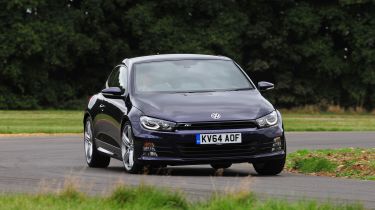Volkswagen Scirocco (2008-2017) review - MPG, CO2 and Running Costs
The Volkswagen Scirocco is economical, clean and holds onto its value, making it an appealing proposition to private and fleet buyers

VW Group cars fitted with the DSG gearbox are often cleaner than the standard-fit manual option. But with the Scirocco, only the R becomes slightly ‘greener’ as a result of having an automatic gearbox – the manual’s 35.3mpg and 187g/km CO2 improving to 35.8mpg and 185g/km CO2 on the DSG.
Elsewhere, choosing the DSG increases carbon dioxide emissions and possibly road tax requirements too. The 148bhp TDI increases from 109 to 119g/km, while the 181bhp TDI increases from 115 to 125g/km. It increases the 2.0 TSI’s emissions from 142 to 148g/km, while the 1.4 TSI is manual only, so always emits 125g/km.
Claimed average fuel economy is reasonable across the range. Even the 1.4 TSI can return 52.3mpg, while the manual 2.0 TSI achieves 46.3mpg. For the manual TDIs, the 150 hits 67.3mpg and the 184 is not far behind at 64.2mpg. For DSG, the same figures are 44.1mpg (2.0 TSI), 62.8mpg (150 TDI) and 58.9mpg (184 TDI).
Benefit-in-Kind company car rates range from 19 per cent for the 148bhp TDI manual up to 24 per cent for the 181bhp TDI DSG, with the R out on its own at 32 per cent.
Insurance groups
Given its sporty intentions, no Scirocco is in a particularly low group for insurance. The 1.4 TSI is in group 21 in either base or GT specifications, while the 2.0 TSI is in group 30 irrespective of its equipment level.
The TDIs range from groups 26-30: the 150 unit is in group 26, or 27 for the R-Line; and the 184 is in 29 for the GT and 30 for the R-Line. The R itself is in a lofty group 39, with either transmission.
Depreciation
Like any Volkswagen, the Scirocco benefits from the brand’s historically strong reputation to holding on to much of its original value, although it remains to be seen whether the coupe’s desirability with buyers will be affected by the emissions scandal that engulfed the company in late 2015.
Scirocco diesels are expected to retain 50 per cent of their value over three years and 36,000 miles as a diesel, while the price range for petrol version is likely to be 45-49 per cent.








